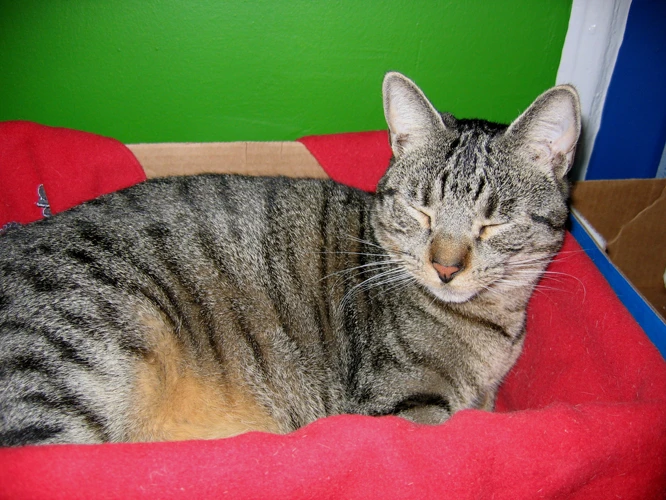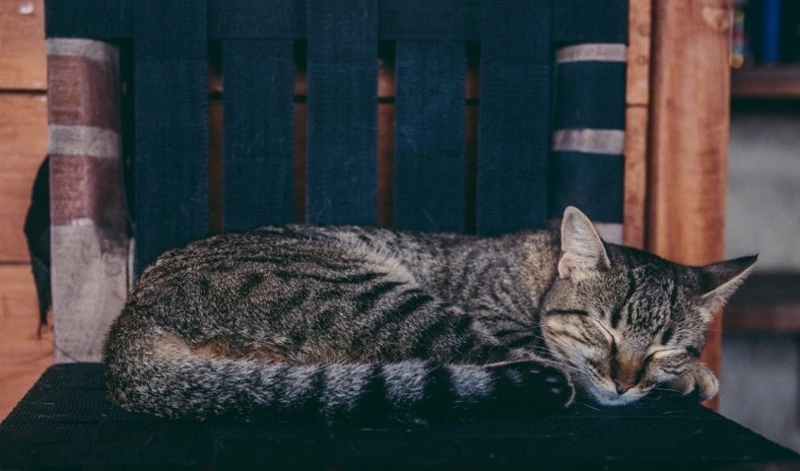If you’re lucky enough to have a spunky and adventurous California Spangled cat, you may be wondering how to teach them new tricks and behaviors. One popular training method is clicker training, a positive reinforcement technique that uses a clicking noise and rewards to encourage desirable behavior. Clicker training has proven to be effective for many cat owners, and with advanced techniques, it’s possible to teach your California Spangled cat even complex behaviors. In this article, we’ll cover everything you need to know about clicker training, from the basics to advanced techniques and problem-solving strategies. So let’s dive in and learn how to train your California Spangled cat like a pro!
What is Clicker Training?

If you’re a California Spangled cat owner looking for a successful training technique, you might have come across clicker training before. Clicker training is a positive-reinforcement method that uses a clicker to signal to your cat when they have performed an action correctly. In this section, we’ll provide a detailed overview of clicker training techniques, including how to teach your cat basic and advanced behaviors, how to address problem behaviors, and why clicker training is an effective form of behavior modification. If you’re interested in learning more about the benefits of clicker training specifically for California Spangled cats, check out our guide to clicker training for California Spangled cats.
Understanding Behavior Modification with Clicker Training
Understanding Behavior Modification with Clicker Training
Clicker training is a positive reinforcement training technique that encourages good behavior by marking it with a “click” sound and then rewarding the cat. Understanding how behavior modification works with this training technique is crucial to its success.
Behavior modification is the process of changing a cat’s behavior through positive reinforcement. Positive reinforcement is when a desirable behavior is rewarded, thus increasing the likelihood of it being repeated in the future. This is different from punishment, where an undesirable behavior is corrected through being given negative consequences.
Clicker training is a form of positive reinforcement that uses a click noise and treat reward system. The click is used to signal the cat that a desirable behavior has been displayed, and this is followed immediately by a treat, which reinforces the behavior. Over time, the cat learns that the click noise means they have done something good, and they will be rewarded for it.
It’s important to note that clicker training works on small behaviors first before progressing to more complex behaviors. This is because it takes time for the cat to learn the connection between the click and the reward. So patience and consistency are key.
It’s important to identify what motivates your California Spangled cat. Some cats are motivated by treats, while others are more responsive to playtime or verbal praise. Understanding what motivates your cat will help you choose the most effective reward for them.
Clicker training is an effective and humane way to modify your cat’s behavior. By using positive reinforcement, and taking the time to teach your cat gradually, you’ll see results over a period of time. To learn more, check out this cat clicker training guide for more tips and tricks on how to effectively train your California Spangled cat.
Why Clicker Training Works So Well
Clicker training works so well because it uses positive reinforcement to train cats. Positive reinforcement is a scientifically proven way to modify behavior. When cats are trained using positive reinforcement, they learn to associate a specific behavior with a positive reward. This creates a strong motivation for the cat to continue performing the behavior, making it more likely the behavior will be repeated in the future.
Here are some reasons why clicker training works so well:
- Clear Communication: Clicker training provides a clear and consistent way to communicate with your cat. The “click” marker sound is always the same, which means that your cat can easily understand when they have performed the desired behavior. This leads to faster learning and less confusion.
- Increases Motivation: Clicker training increases your cat’s motivation to learn and perform new behaviors. With traditional training methods, it can be challenging to find a reward that your cat is interested in. However, with clicker training, you can use a variety of rewards – such as food, toys, and affection – to find what motivates your cat the most.
- Builds Trust: Clicker training is a force-free training method, which means that it does not use any physical punishment or aversive methods. This can help build trust between you and your cat, leading to a stronger bond and better relationship.
- Adaptable: Clicker training can be used to teach a wide variety of behaviors, from simple tricks to more complex tasks. Plus, it can be easily adapted to work with cats of different ages, breeds, and temperaments.
- Fosters Problem-Solving: Clicker training encourages cats to think and problem-solve. Because cats are working to figure out what behavior is being reinforced, they are more likely to experiment and try new things – leading to more learning opportunities and better problem-solving skills.
Using clicker training techniques specifically tailored for California Spangled cats can be incredibly effective, too. By taking into account the characteristics and personality traits of this unique breed, you can enhance the effectiveness of your training and help your cat to learn more quickly and easily. Additionally, understanding the differences between clicker training and traditional training methods can help you to decide which approach is best for you and your cat.
Basic Clicker Training Techniques

As a California Spangled cat owner, you want to make sure your furry friend is well-trained and behaves appropriately. Basic clicker training techniques can be a great way to teach your cat new behaviors and reinforce positive actions. By using a clicker and treats, you can teach your cat to respond to the sound of the clicker and perform simple actions. This will form the foundation for more advanced clicker training techniques that can help your cat learn more complex behaviors. But before jumping into the training process, make sure you understand the basics of clicker training, as well as common mistakes to avoid. For more information, check out our previous article on clicker training mistakes to avoid.
Teaching Your Cat to Respond to the Clicker
To start your cat’s clicker training, the first step is to teach them to respond to the sound of the clicker. This is the foundation of clicker training, and it’s important that your cat understands that the sound of the clicker means they’ve done something right and a treat is coming.
Step 1: Choose an appropriate treat for your cat. It should be something that they really enjoy, such as pieces of cooked chicken or small bits of tuna.
Step 2: Find a quiet room where you can work with your cat without any distractions.
Step 3: Hold the clicker in one hand and a treat in the other hand. Sit down on the floor with your cat.
Step 4: Press the clicker and then immediately give your cat a treat. Repeat this process a few times, until your cat starts to associate the click with receiving a treat.
Step 5: Once your cat starts to associate the click with receiving a treat, try pressing the clicker when your cat is doing something they enjoy, such as playing with a toy. Click the clicker and then immediately give your cat a treat. This helps your cat understand that the click means they’re doing something right.
Step 6: Repeat this process several times a day for a few days until your cat consistently responds to the clicker by looking at you or coming to you for a treat.
It’s important to keep the training sessions short, no more than five to ten minutes at a time. You don’t want to overwhelm your cat or them to lose interest. Gradually increase the duration and difficulty of the training as your cat gets more comfortable with the clicker.
Remember to always use positive reinforcement during training. Instead of punishing your cat for doing something wrong, focus on rewarding them for doing things correctly. This will help create a positive association with training and make it more enjoyable for both you and your cat.
Once your cat understands the clicker, you can move on to teaching them more advanced clicker training techniques, such as shaping behaviors and teaching complex actions. For more information on clicker training California Spangled cats, check out our guide on advanced clicker training techniques for California Spangled cats.
Teaching Your Cat to Perform Simple Actions
Teaching Your California Spangled Cat to Perform Simple Actions
Training your California Spangled Cat to perform simple actions is a vital step in clicker training. It is the foundation upon which you can build more complex behavior. The goal of this type of training is to teach your cat to associate the clicker sound with a particular action or behavior. From there, you can start to introduce more complex actions.
To start, pick a simple behavior, such as sitting or coming to you when called, and focus on this behavior until your cat is consistently responding to the clicker.
| Step | Description |
|---|---|
| Step 1 | Get your cat’s attention by calling its name or making a noise. |
| Step 2 | Ask your cat to perform the action, such as sitting. |
| Step 3 | As soon as your cat performs the action, click the clicker and immediately give it a treat. |
| Step 4 | Repeat the process several times, until your cat is consistently performing the action in response to the clicker. |
Remember, it is important to click the clicker at the exact moment your cat performs the desired action. If you click too early or too late, your cat may not make the association between the click and the behavior.
Once your cat has mastered one behavior, you can move on to the next. The key is to gradually increase the complexity of the action, always rewarding your cat for responding to the clicker.
Using positive reinforcement training techniques like clicker training can help your California Spangled Cat learn important behaviors while also strengthening the bond between you and your beloved pet.
If you’re dealing with a cat that is fearful or anxious, we highly recommend our guide on training California Spangled cats with fear and anxiety using clicker training. For those interested in the science behind clicker training, our article on the science of clicker training for California Spangled cats is a must-read.
Teaching Your Cat to Follow a Target
One advanced clicker training technique for California Spangled Cats is teaching them to follow a target. This technique is useful for training your cat to come when called or to walk on a leash. Here are the steps to help you teach your cat to follow a target:
Step 1: Choose Your Target
Choose an object that your cat can easily see and focus on, such as a small toy or a treat. Hold the target about a foot away from your cat’s nose and wait for them to show an interest in it.
Step 2: Click and Reward
As soon as your cat looks at the target, click the clicker and give them a treat. Repeat this several times so that your cat starts to associate the click with the treat.
Step 3: Move the Target
Once your cat is consistently looking at the target when you present it, start moving it around to see if your cat will follow it. Move it slowly and keep it close to the ground at first.
Step 4: Click and Reward for Following
When your cat does follow the target, click the clicker and give them a treat. Start moving the target farther away and rewarding your cat for following it.
Step 5: Add Verbal Cues
Once your cat is reliably following the target, add a verbal cue such as “come” or “follow.” Say the cue just before presenting the target, and then click and reward when your cat follows.
Step 6: Practice Consistently
Practice this exercise for a few minutes each day until your cat consistently follows the target when given the verbal cue. Gradually increase the distance and difficulty of the exercise.
Following a target is a helpful skill for many other behaviors and tricks, such as jumping through hoops or retrieving objects. With practice, your California Spangled Cat can become a pro at following targets and impressing all their friends.
Advanced Clicker Training Techniques

You’ve mastered the basics of clicker training with your California Spangled Cat and are ready to take it to the next level. By incorporating some advanced clicker training techniques, you can challenge your cat to learn even more complex behaviors and become an even more well-behaved and intelligent pet. In this section, we’ll explore some cutting-edge techniques for shaping behaviors, teaching complex actions, and chaining together multiple behaviors in sequence. Your cat is sure to impress with their new skills, and you’ll feel proud as their devoted trainer. So grab your clicker and let’s get started!
Shaping Behavior with Clicker Training
Shaping behavior with clicker training is an advanced technique that can help you train your California Spangled cat to perform complex actions. This technique involves breaking down a desired behavior into smaller, achievable actions that gradually lead to the end goal.
The Shaping Process
To begin shaping behavior with clicker training, you’ll need to first identify the final behavior you want to teach your cat. For example, you may want to teach your cat to jump on a specific spot on command. Once you have identified the final behavior, you’ll need to break it down into smaller actions that lead up to the final behavior. In this example, you may start by rewarding your cat for approaching the spot you want them to eventually jump on.
The Power of Reinforcement
Reinforcement is a critical part of the shaping process. It involves using the clicker and a treat to reward your cat for performing the desired behavior. It’s important to remember that the clicker is used to mark the exact moment your cat performs the desired behavior, and the treat is used as a reward for doing so. Over time, your cat will start to associate the click with the treat and will perform the desired behavior more frequently.
Patient, Incremental Progress
Shaping behavior with clicker training can take time and patience. You’ll need to start with small, achievable actions and build up to the final behavior gradually. It’s important to be consistent with your clicker and treat timing and to avoid rewarding undesired behaviors.
Example Shaping Plan
To give you an idea of how shaping behavior with clicker training works, here’s an example shaping plan for teaching your cat to jump up onto a specific spot on command:
| Step | Action |
|---|---|
| Step 1 | Reward your cat for approaching the spot where you eventually want them to jump. |
| Step 2 | Reward your cat for standing on the spot. |
| Step 3 | Reward your cat for taking a small hop onto the spot. |
| Step 4 | Reward your cat for jumping on the spot. |
| Step 5 | Add a verbal command, like “Jump”, before rewarding your cat for jumping on the spot. |
Remember that shaping behavior with clicker training can take time, but the process can be incredibly rewarding as you see your cat progress towards the desired behavior. With patience and consistency, you’ll be able to train your California Spangled cat to perform complex actions through the power of shaping behavior with clicker training.
Teaching Complex Behaviors with Clicker Training
Clicker training is a powerful and rewarding way to teach your California Spangled Cat complex behaviors. The process of shaping behavior with clicker training requires patience and consistency, but the results are worth the effort. Here are some tips for teaching complex behaviors with clicker training:
1. Break it down: To teach a complex behavior, break it down into smaller, manageable steps. For example, if you want to teach your cat to jump through a hoop, start by rewarding them for touching the hoop, then for putting a paw on it, then for jumping over it from a short distance, and gradually increase the difficulty until your cat is jumping through the hoop from a distance.
2. Reward incremental progress: When you are training a complex behavior, it is important to reward your cat for incremental progress. Click and treat any progress towards the final behavior, not just the final behavior itself. This will help keep your cat motivated and engaged in the training process.
3. Use shaping: Shaping is a technique used in clicker training to gradually shape a behavior by reinforcing closer and closer approximations to the final behavior. For example, if you want to teach your cat to jump through a hoop, start by rewarding them for just looking at the hoop, then for moving towards the hoop, then for touching the hoop, and so on, until your cat jumps through the hoop.
4. Be consistent: Consistency is key when teaching complex behaviors with clicker training. Use the same clicker sound and treat reward every time. Make sure your cues and rewards are consistent and your cat will soon learn what is expected of them.
5. Be patient: Teaching complex behaviors takes time and patience. Don’t rush the process and make sure you allow your cat time to learn at their own pace. If you get frustrated, take a break and come back to it later.
By following these tips, you can use clicker training to teach your California Spangled Cat a variety of complex behaviors. Remember to take it one step at a time and be patient with your cat. With consistent training and practice, your cat will soon be performing amazing feats!
Teaching Your Cat to Perform Multiple Actions in Sequence
One of the advanced clicker training techniques for California Spangled Cats is teaching them to perform multiple actions in sequence. This can be very challenging, but it is also a great way to mentally stimulate your cat and provide them with a fun, rewarding experience.
The first step in teaching your cat to perform multiple actions in sequence is to break down the desired sequence of actions into smaller, individual actions. For example, if you want your cat to jump over a hurdle, spin around, and then come back to you, you would first need to teach them each of these actions separately.
Table: Teaching Multiple Actions in Sequence
| Behavior | Method |
|---|---|
| Jumping over a hurdle | Use a combination of shaping and targeting techniques. First, teach your cat to jump over a stationary object, such as a pole or a box. Then, gradually increase the height of the object until your cat is able to jump over the hurdle. |
| Spinning around | Start by teaching your cat to follow a target, such as a treat or a toy, in a semicircle. Gradually increase the distance of the target until your cat is spinning all the way around. |
| Coming back to you | Teach your cat to come to you on command by using a verbal cue, such as “come” or a hand signal. Reward your cat with treats and praise when they come to you. |
Once your cat has learned each of these individual actions, you can begin to string them together into a sequence. Start by practicing each action separately, and then gradually combine them in different orders until your cat can perform the entire sequence smoothly and without hesitation.
Remember to always use positive reinforcement techniques, such as treats and praise, to reward your cat for their progress and motivate them to continue learning. With patience and persistence, you can teach your California Spangled Cat to perform impressive sequences of actions that will be sure to impress your friends and family.
Problem Solving with Clicker Training
As much as we love our California Spangled cats, sometimes they exhibit behaviors that can be quite challenging to deal with. From scratching furniture to incessant meowing, these issues can try our patience. However, with the help of advanced clicker training techniques, these problems can be solved in a positive and effective manner. In this section, we will delve into how clicker training can be used as a tool to address unwanted cat behaviors, teaching your feline friend to replace them with more desirable actions. So buckle up, and let’s help your kitty become the best version of themselves with the power of clicker training.
Teaching Your Cat to Stop Unwanted Behaviors
When it comes to cat training, stopping unwanted behaviors can be a challenge. However, clicker training provides an effective solution for correcting unwanted behaviors in cats. Here are some advanced clicker training techniques to stop unwanted behaviors in your California Spangled cat:
Identify the Unwanted Behavior: Before you start training your cat to stop an unwanted behavior, you need to identify the behavior you want to correct. This can be anything from scratching furniture, biting, or jumping up on counters.
Introduce a Cue: Once you have identified the unwanted behavior, you need to introduce a cue that lets your cat know that the behavior is unwanted. For example, if your cat is scratching furniture, introduce a cue like “no scratching” every time you catch them in the act.
Create a Deterrent: Next, create a deterrent that will discourage your cat from carrying out the unwanted behavior. For example, if your cat is scratching furniture, try placing double-sided tape on the furniture or a scratching post nearby to redirect their behavior.
Use Positive Reinforcement: While stopping unwanted behaviors, it’s important to use positive reinforcement to encourage your cat to stop the unwanted behavior. Every time your cat stops the unwanted behavior after hearing the cue, reward them with a treat and some praise.
Punishment is Not the Solution: It’s crucial to avoid punishing your cat when correcting unwanted behaviors, as it can often lead to more stress and fear. Plus, it doesn’t fix the root of the problem, which is why clicker training focuses on positive reinforcement instead.
| Steps | Details |
|---|---|
| Identify the Unwanted Behavior | Examples include scratching furniture, biting, or jumping up on counters. |
| Introduce a Cue | Use a simple, consistent cue like “no scratching” or “off” |
| Create a Deterrent | Examples include double-sided tape, scratching posts, or motion-activated sprays |
| Use Positive Reinforcement | Reward your cat with treats and praise every time they stop the unwanted behavior |
| Punishment is Not the Solution | Avoid punishing your cat, as it can cause more stress and fear |
With patience and consistency, clicker training can help correct your California Spangled cat’s unwanted behaviors. Remember to focus on positive reinforcement rather than punishment and to be consistent in your training.
Teaching Alternative Behaviors with Clicker Training
One of the great benefits of clicker training is that it allows you to teach your California Spangled cat alternative behaviors to replace unwanted ones. This is a great way to discourage undesirable habits and encourage more positive behavior in your cat.
Identify the negative behavior: The first step in teaching alternative behaviors is to identify the negative behavior that you want to discourage. This could be anything from scratching the furniture to jumping on the counter.
Find a replacement behavior: Once you’ve identified the negative behavior, you need to find a replacement behavior that you want your cat to engage in. For example, if your cat is scratching the furniture, you could teach them to use a scratching post instead.
Click and reward: When your cat engages in the replacement behavior, click the clicker and give them a treat. You want your cat to associate the click with the positive behavior so that they will be more likely to repeat it in the future.
Be consistent: Consistency is key when it comes to clicker training. Make sure to click and reward your cat every time they engage in the replacement behavior. This will help to reinforce the behavior and make it more likely that your cat will continue to do it in the future.
Here’s an example of how you could use clicker training to teach your cat to use a scratching post instead of scratching the furniture:
| Negative Behavior | Replacement Behavior |
|---|---|
| Scratching the furniture | Using the scratching post |
To teach this behavior, you would need to place the scratching post near the furniture that your cat likes to scratch. Every time you see your cat using the scratching post, click the clicker and give them a treat. With repetition, your cat will start to associate the scratching post with the positive reinforcement and will be more likely to use it instead of the furniture.
Remember, clicker training is a positive reinforcement technique, so make sure to always reward your cat for engaging in the replacement behavior rather than punishing them for the negative behavior. With patience and consistency, your California Spangled cat can learn new, positive behaviors through clicker training.
Conclusion
In conclusion, clicker training can be a highly effective way of training your California Spangled cat, making it an ideal choice for pet owners looking to adjust their cat’s behaviour. By using a clicker as a marker signal and reinforcing positive behaviour with treats, you can shape your cat’s actions and behaviours in a way that is both humane and fun for both you and your furry friend.
While the techniques and methods outlined in this article are primarily focused on advanced clicker training techniques, it’s important to remember that they all build off of the fundamental building blocks of basic clicker training techniques. By taking the time to teach your cat to associate the sound of the clicker with something positive, and reinforcing that behaviour with treats or other rewards, you’ll set the stage for more advanced training techniques down the line.
Remember to take it slow and be patient with your cat – effective clicker training takes time, effort, and consistency. With practice, it’s possible to teach your California Spangled cat to perform complex actions, follow a target, and even perform multiple actions in sequence. And in the process, you’ll develop a deeper bond with your pet while providing them with the structure and encouragement they need to be happy and healthy.
So whether you’re looking to address unwanted behaviours, teach new tricks, or simply have some fun with your feline companion, clicker training can be an excellent tool to add to your training arsenal. With the right tools, techniques, and mindset, you can unlock a whole new world of possibilities in your cat’s behaviour.
Frequently Asked Questions
What supplies do I need for clicker training my California Spangled Cat?
You will need a clicker, treats, a target stick (can be a chopstick or a pen), and possibly a leash or harness for outdoor training.
How often should I train my California Spangled Cat with clicker training?
Training sessions should be kept short and sweet, around 5-10 minutes a day, and can be done multiple times a day.
Can clicker training work for older cats?
Yes, cats of all ages can benefit from clicker training. However, it may take longer for older cats to learn new behaviors and tricks.
What is shaping behavior, and how can it be used in clicker training?
Shaping behavior is the process of rewarding incremental steps towards a goal behavior. It can be used in clicker training to teach complex behaviors by breaking them down into smaller, achievable steps.
What if my cat doesn’t seem interested in the treats during clicker training?
You may need to try different types of treats to find something your cat finds irresistible. You can also try using their favorite toys as a reward instead.
How can I use clicker training to improve my California Spangled Cat’s behavior?
Clicker training can be used to teach alternative behaviors to replace unwanted behaviors, or to reinforce positive behaviors your cat is already exhibiting.
Can clicker training be used to teach my cat to come when called?
Yes, you can use clicker training to teach your cat to come when called by associating the sound of the click with a treat or reward.
How long does it typically take for a cat to learn a new behavior with clicker training?
It depends on the complexity of the behavior and the individual cat’s ability to learn, but many simple behaviors can be learned within a few training sessions.
Can clicker training help improve my bond with my California Spangled Cat?
Yes, clicker training can be a fun and rewarding way to bond with your cat and strengthen your relationship.
Is it possible to accidentally train my cat to do something unwanted with clicker training?
While it’s possible, it’s unlikely if you are following proper clicker training techniques and only rewarding the behaviors you want to reinforce.







